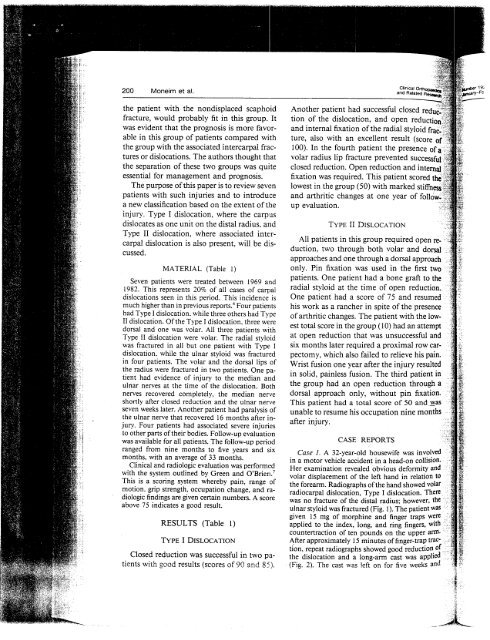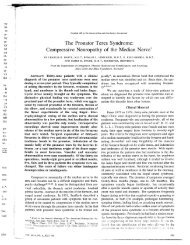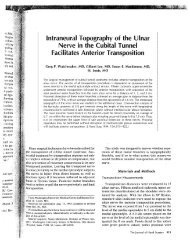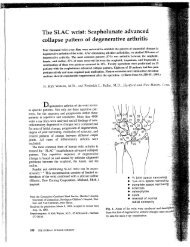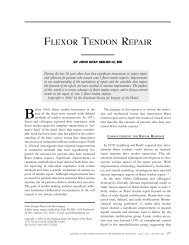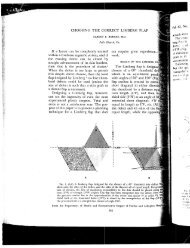Radiocarpal Dislocation Classification Rationale for Management and
Radiocarpal Dislocation Classification Rationale for Management and
Radiocarpal Dislocation Classification Rationale for Management and
Create successful ePaper yourself
Turn your PDF publications into a flip-book with our unique Google optimized e-Paper software.
200 Moneim et al.<br />
the patient with the nondisplaced scaphoid<br />
fracture, would probably fit in this group. It<br />
was evident that the prognosis is more favorable<br />
in this group of patients compared with<br />
the group with the associated intercarpal fractures<br />
or dislocations. The authors thought that<br />
the separation of these two groups was quite<br />
essential <strong>for</strong> management <strong>and</strong> prognosis.<br />
The purpose of this paper is to review sewm<br />
patients with such injuries <strong>and</strong> to introduce<br />
a new classification based on the extent of the<br />
injury.. Type I dislocation, where the carpus<br />
dislocates as one unit on the distal radius, <strong>and</strong><br />
Type II dislocation, where associated intercarpal<br />
dislocation is also present, will be discussed.<br />
MATERIAL (Table 1)<br />
Clinical<br />
<strong>and</strong> Related<br />
Another patient had successful closed red,<br />
tion of the dislocation, <strong>and</strong> open<br />
<strong>and</strong> internal fixation of the radial st<br />
ture, also with an excellent result (score of<br />
100). In the fourth patient the presence of~<br />
volar radius lip fracture prevented su~<br />
closed reduction. Open reduction <strong>and</strong> internal<br />
fixation was required. This patient scored 1<br />
lowest in the group (50) with marked sti:<br />
<strong>and</strong> ~ arthritic changes at one year of folh<br />
up evaluation.<br />
TYPE II DISLOCATION<br />
All patients in this group required open<br />
duction, two through both volar <strong>and</strong><br />
approaches <strong>and</strong> one through a dorsal approach<br />
only. Pin fixation was used in the first two<br />
patients. One patient had a bone graft to the<br />
radial styloid at the time of open reduction.<br />
One patient had a score of ?5 <strong>and</strong> resumed<br />
his work as a rancher in spite of the presence<br />
of arthritic changes. The patient with the lowest<br />
total score in the group (i 0) had an attempt<br />
at open reduction that was unsuccessful <strong>and</strong><br />
six months later required a proximal row carpectomy,<br />
which also failed to relieve his pain.<br />
Wrist fusion one year after the injury resulted<br />
in solid, painless fusion. The third patient in<br />
the group had an open reduction through a<br />
dorsal approach only, without pin fixation.<br />
This patient had a total score of 50 <strong>and</strong>__was<br />
unable to resume his occupation nine months<br />
after injury.<br />
Seven patients were treated between 1969 <strong>and</strong><br />
1982. This represents 20% of all cases of carpal<br />
dislocations seen in this period. This incidence is<br />
much higher than in previous reports. 4 Four patients<br />
had Type I dislocation, while three others had Type<br />
II dislocation, Of the Type I dislocation, three were<br />
dorsal <strong>and</strong> one was volar. All three patients with<br />
Type II dislocation were volar. The radial styloid<br />
was fractured in all but one patient with Type: I<br />
dislocation, while the ulnar styloid was fractured<br />
in four patients. The volar <strong>and</strong> the dorsal lips of<br />
the radius were fractured in two patients. One patient<br />
had evidence of inju~ to the median <strong>and</strong><br />
ulnar nerves at the time of the dislocation. Both<br />
nerves recovered completely, the median nerve<br />
shortly after closed reduction <strong>and</strong> the ulnar nerve<br />
seven weeks later. Another patient had paralysis of<br />
the ulnar nerve that recovered 16 months after injury,.<br />
Four patients had associated severe injuries<br />
to other parts of their bodies. Follow-up evaluation<br />
was available <strong>for</strong> all patients. The follow-up period<br />
CASE REPORTS<br />
ranged from nine months to five years <strong>and</strong> six<br />
months, with an average of 33 months.<br />
Clinical <strong>and</strong> radiologic evaluation was per<strong>for</strong>med<br />
with the system outlined by Green <strong>and</strong> O’Brien. 7<br />
This is a scoring system whereby pain, range of<br />
motion, grip strength, occupation change, <strong>and</strong> radiologic<br />
findings are given certain numbers. A score<br />
above 75 indicates a good result.<br />
Case 1. A 32-year-old housewife was involved<br />
in a motor vehicle accident in a head-on collision.<br />
Her examination revealed obvious de<strong>for</strong>mity <strong>and</strong><br />
volar displacement of the left h<strong>and</strong> in relation to<br />
the <strong>for</strong>earm. Radiographs of the h<strong>and</strong> showed volar<br />
radiocarpal dislocation, Type I dislocation. There<br />
was no fracture of the distal radius: however, the<br />
ulnar styloid was fractured (Fig. 1). The patient was<br />
given 15 mg of morphine <strong>and</strong> finger traps were<br />
RESULTS (Table 1)<br />
applied to the index, long, <strong>and</strong> ring fingers, with<br />
countertraction of ten pounds on the upper arm. ¯<br />
TYPE I DISLOCATION<br />
Closed reduction was successful in two patients<br />
with good results (scores of 90 <strong>and</strong> 85).<br />
After approximately 15 minutes of finger-trap trac-_<br />
tion, repeat radiographs showed good reduction<br />
the dislocation <strong>and</strong> a long-arm cast was applied<br />
¯ (Fig. 2). The cast was !eft on <strong>for</strong> five weeks <strong>and</strong>


